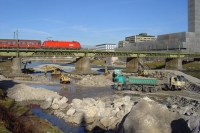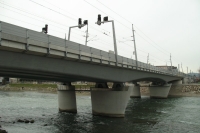Salzburg Municipal Railway
Client: Austrian Railways Infrastructure AG
Development Period: 1998 to 2016
In order to cope with increasing traffic in the future, the municipal railway network in Salzburg was being upgraded. For this purpose, the existing railway infrastructure between Salzburg - Golling, Salzburg - Saalach Bridge/Freilassing and Salzburg - Strasswalchen has been used and extended.
In this connection, 12 new railway stops, numerous bridges and underpasses, trough structures and retaining structures had to be built or adapted. Furthermore, the section of Salzburg Main Station - Saalach Bridge/Freilassing was expanded into a triple-track line.
Along the whole section, the new tracks run parallel and in close vicinity to the existing tracks. Consequently, all the work had to be done in consideration of the heavy traffic experienced by the railway routes.
BGG Consult was responsible for the geotechnical and hydrogeological consulting of all the sections of the project. Based on subsoil investigations, geotechnical and hydrogeological expert's reports were compiled that were necessary for the application of the construction permit, and subsequently for the tender procedure.
During the tender preparation phase, intensive participation of BGG Consult was essential due to the challenging condition of the subsoil.
During construction, BGG Consult was responsible for the following tasks: The geotechnical supervision and evaluation of the project plan; The planning of building-pit slopes and groundwater lowering measures; And finally, the preservation of the hydrogeological evidence.
Salzach Bridge:
It was a special challenge to construct a new bridge across the Salzach River, while keeping two tracks operational for use. A complex construction procedure had to be conducted where one single-track and one double-track bridge was built. Some of the river pylons had to be fabricated below the existing bridge.
The loads of the structures are transferred via bored piles (Ø 120 cm) into the sustainable moraine, which declines along the bridge from 10 m to 30 m below the top of the pile. Accordingly, the pile lengths vary between 15 m and 35 m.
The building pit in the river was secured by sheet piles lowered down to the lacustrine clay, which exists between the upper quartenary gravel and the moraine.
Further, construction was only possible in winter time during low water periods.
Before the construction could be started, it was essential to secure the riverbed extensively against flood damage, especially due to the reduction of the cross section area.
May 2017

